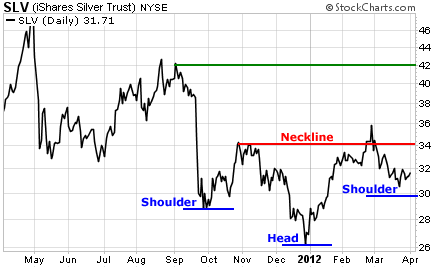 “How do you know which option to trade?”
“How do you know which option to trade?”
A reader recently e-mailed me that question. He liked last week’s essay on silver and the idea of buying call options on SLV (the iShares Silver Fund). But there are hundreds of options to choose from… And picking the best one can be confusing…
You can buy SLV calls that expire a few weeks from now… You can go all the way out to January 2014… Or you can pick from any number of expiration months in between.
You also have a number of strike prices to choose from. (That’s the price at which you can either buy – in the case of call options – or sell – in the case of put options – the underlying stock.) The strike prices in SLV range from a low of $10 per share to a high of $72.
[ad#Google Adsense 336×280-IA]Picking the right option can be a tough decision.
And it often makes the difference between a good trade and a bad one.
So this week, I’m going to take a break from my recent bearish slant on the market in general… and teach you how to pick the right option.
First, let’s get the disclaimer out of the way…
What you’re about to read is an example of how I would select an option on SLV. It is for educational purposes only and is not a recommendation. The prices may or may not reflect what is actually available. Also, remember… option trading involves risk, and you can lose all the money you put into the trade. So do not risk more than you can afford to lose.
Now, let’s figure out how to pick the right expiration month…
When you buy an option, you’re buying time for the stock to do something. The more time you buy, the more expensive the option. You want to be sure to buy enough time for the stock to complete the move you’re anticipating. But you don’t want to pay extra for the time you don’t need…
If you’re anticipating a stock will move higher because of some fundamental factor – like a positive earnings report or a favorable introduction of a new product – you need to buy an option that expires after the event.
For example, if you think XYZ biotech stock is going to shoot higher after an FDA meeting in late May, you need to buy an option that expires in June. An April contract does you no good.
There’s no point buying July or August options in this case, as you’d simply be paying for time you don’t need.
However, if you’re buying an option based on a technical chart pattern for a stock… things get a little trickier.
Some chart patterns resolve quickly. Rising and falling wedges, for example, usually lead to sudden moves in the stock once support or resistance is taken out. In these cases, you can trade options with short expiration dates.
But in the case of SLV, we’re looking at a complex inverse “head and shoulders” pattern. In this pattern, symmetry is important, and it’s going to take some time to play out. Here’s an updated look at the chart…

There are two potential price targets on this chart. The first is the red resistance line (neckline) at about $34.50 per share. The more significant target is the green resistance line at $42.
If this pattern develops into an inverse “head and shoulders” pattern, SLV should form the right shoulder by rallying up to the neckline. The right shoulder began forming in late September and hit the neckline in late October. So it took one month to form the shoulder.
The left shoulder looks like it started forming two weeks ago, around mid-March. So to create a symmetrical pattern, SLV would need to rally back to the neckline by mid-April. Anyone looking to trade this move should look to buy an option with a May expiration date – just to be on the safe side.
The bigger move, however, will come if the inverse “head and shoulders” pattern plays out and SLV breaks above the neckline. The pattern projects an $8 move higher, which is the distance from the head to the neckline. This move should take another two months to complete. Here’s how we figure that out…
The decline from the neckline down to the head started in late October and finished in late December – a period of two months. The rally from the head back up to the neckline also took two months. So again, for the sake of symmetry… once SLV breaks above the neckline, it should take two months to complete the projected move.
To sum it all up… SLV should rally back up to the neckline by mid-April. Then, a breakout and a rally up to the $42 resistance line should take another two months. That brings us to mid-June.
Traders looking to take advantage of this trade should look at the July series of SLV options. The May contracts don’t give us quite enough time. And there’s no need to pay extra for the October options (the next month available), since this pattern should play out well before then.
In my next essay, we’ll take a look at which of the SLV July strike prices makes the most sense for this trade.
Best regards and good trading,
Jeff Clark
[ad#jack p.s.]
Source: The Growth Stock Wire


